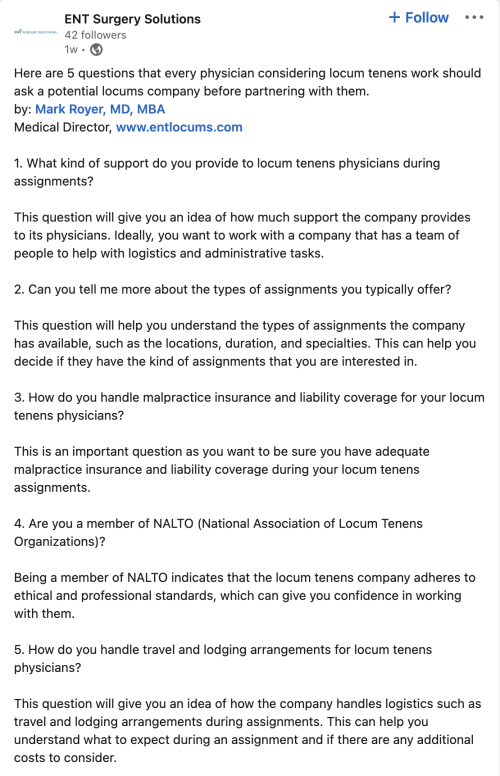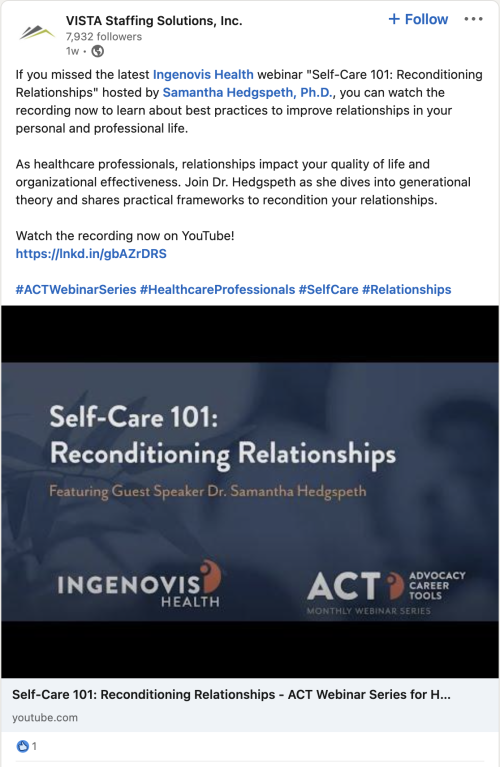In This Issue:
- Doximity-OpenAI Collaborative Aims to Address Physician Burnout
- Locum Providers and Rural Facilities: Finding the Right Fit
- Locum Tenens Enhances Work-Life Balance for Each Generation
- 7 Reasons Why Doctors Choose Locum Tenens
- 6 Reasons Why Physicians Struggle with Imposter Syndrome
- Best 2023 Travel Discounts for Docs
- 6 Questions to Ask Before Signing a Physician Employment Contract
- Socially Speaking: Posts of note from ENT Surgery Solutions, VISTA Staffing, Weatherby, Wilderness Medical, Consilium & more.
- How Physician Net Worth, Debt Has Changed in the Last 5 Years
- The Wealthiest US Physician is Worth $22.6B
Doximity-OpenAI Collaborative Aims to Address Physician Burnout
(From Healthcare IT News, 2/21/2023)
Doximity, a social network designed for healthcare professionals in the United States, has collaborated with OpenAI to introduce DocsGPT: an AI-powered chatbot specially designed for doctors. This chatbot can help doctors perform administrative tasks and reduce the workload contributing to burnout. With DocsGPT, doctors can now “cut the scut” and focus on providing better patient care.
DocsGPT uses OpenAI’s natural language processing model, ChatGPT, specially trained on healthcare-specific prose. The bot is free and can help doctors prepare referrals, certificates of medical necessity, prior authorization requests, and letters about medical conditions. It also offers a growing menu of prompts with options to type in custom requests.
Doximity’s integration of DocsGPT with its established HIPAA-compliant fax service enables doctors to fax their AI-created authorizations and communications directly to health insurers. This app allows doctors to review and edit the AI-generated responses in a secure environment before sending them to the appropriate insurer. The website reminds users at each step of document creation to edit for accuracy and not to include patient identifiers or other protected health information.
DocGPT’s Limitations
The accuracy of DocsGPT’s communication relies on the user following its instructions. Although the bot has limitations, DocsGPT has received positive feedback from doctors. They have reported that it can quickly and accurately draft insurance claim denial appeal letters, letters of recommendation for medical students, and post-procedure instruction sheets.
Doximity’s co-founder and chief strategy officer, Dr. Nate Gross, said doctors still handle a lot of paperwork, which is still sent via fax machines. He believes that DocsGPT can help physicians be more productive, allowing them to focus more on what matters most — spending more time with their patients. While this is the primary use case for DocsGPT, the chatbot has limitations, as seen in the mixed results of asking the bot to plan a vacation after a conference.
DocsGPT’s limitations are not unique, as AI-powered chatbots are still in their early stages of development. ChatGPT, for example, has made headlines for writing a viral letter to an airline voicing displeasure over how flight delays are handled. While applications using ChatGPT are still emerging, they hold promise in healthcare, particularly for streamlining administrative tasks.
In collaboration with OpenAI, Microsoft trained ChatGPT using multiple learning methodologies, including human trainers, to improve its performance. The project helped OpenAI develop an AI model that can help streamline administrative tasks in healthcare.
The App’s Future in Healthcare
DocsGPT is currently in beta, and while it has a long way to go, it holds promise in assisting physicians to be more productive and focus more on patient care. However, Doximity’s Dr. Gross warns that while the technology is promising, it’s not flawless and should still be approached judiciously.
The integration of AI with healthcare is gaining traction, and its potential is exciting. AI-powered tools like DocsGPT can help healthcare professionals streamline administrative tasks and reduce burnout, enabling them to focus more on patient care. AI-powered chatbots also could help improve patient outcomes, reduce healthcare costs, and produce faster and more accurate diagnoses.
With further refinement, AI-powered chatbots like DocsGPT could help revolutionize healthcare, offering patients more personalized and efficient care.
Your Locums Prescription
(From Wapiti Medical Staffing, 2/21/2023)
In a recent blog post, Wapiti Medical Staffing shared survey results on the hospitals and providers they serve in rural areas. While qualifications and experience are essential, Wapiti found that, whether it’s a locums or a permanent assignment, matching a provider’s goals and expectations with what the facility and community offer is equally critical.
For rural providers looking to find the right fit, Wapiti suggested the following tips:
1. Be Clear About Your Motivation
What draws you to a rural community? Is it the lower cost of living, the smaller class sizes in local schools, or the sense of community? Sharing your reasons with potential employers can positively impact their decision.
2. Community Connection
Having a connection to the area can give you a significant advantage. Let the facility know if you’re from the region or have family nearby. Strong ties increase the likelihood of your happiness in a small community and decrease the chances you’ll be lured away by big-city living.
3. Hobbies
Wapiti also suggested sharing your hobbies and interests with prospective employers. Rural areas offer unique outdoor activities like camping, hiking, and fishing. If your hobbies align with the area, the facility is more likely to believe you’ll remain content.
Even during a physician shortage, smaller hospitals are selective about which providers they bring on board. Having a provider leave after a brief stay is a setback rural facilities want to avoid.
Being clear about why you want to come to their community helps employers feel more secure in making you part of their team.
(From All Star Healthcare Solutions, 1/31/2023)
A recent blog post from All Star Healthcare Solutions focused on how burnout can affect physicians differently depending on their generation.
Locum tenens offers physicians of all generations a chance to balance their careers and their personal lives in ways that work for them. In its late-January blog post, All Star offered insight into how their needs can differ at different life stages.
Baby Boomers Ease into Retirement
Born between 1946 and 1964, Baby Boomers account for nearly 45% of practicing physicians, according to the Association of American Medical Colleges (AAMC).
After building long careers, they can gain schedule flexibility and reduce administrative burden through from locum tenens, accepting locums assignments every few weeks or months. This allows boomers to work enough to keep skills sharp and maintain professional satisfaction while pursuing interests they might have set aside earlier decause of professional overload.
Generation X Assumes More Family Obligations
Born between 1965 and 1980, Gen X providers represent the sandwich generation: caring for both children still living at home and aging parents while still engaged in full-time careers.
Also this demographic generally carries greater debt loads than older providers–from mortgages and medical school loans to educational costs for their children.
Switching to a full-time locum tenens career offers the opportunity to block out periods between assignments to coach children, spend time with parents, or engage in leisure activities more frequently. Likewise, adding occasional locum tenens jobs to a permanent position can supplement income to help pay down debt or boost retirement savings.
Millennials Reset Expectations
Also known as Gen Y, Millennials (born 1981-1997) often prefer to break from traditional careers. Most older Millennial physicians have been established in their practices for several years while the youngest are wrapping up training and seeking their first post-residency roles.
Surveys show Millennials value work-life balance as much as, if not more than, income and employment perks. They expect more employer investment into supporting their well-being, which may include fewer hours on the job. Integrating more non-clinical interests is essential to this generation for both personal and professional satisfaction.
Gen Z Looks Ahead
Gen Z providers (born 1997-2012) are early into their medical careers, yet looking ahead to what type of work/life balance they hope to strike after training. Research on Gen Zers in other industries indicates schedule flexibility, like taking off for mental health days, will be just as valuable early in one’s medical career as earning potential.
The locum tenens career alternative offers more flexibility and freedom, and it’s a viable option to pursue right out of residency without committing to a long-term employment contract. It also offers options to travel, discover regional cultures, and assess future goals based along the way.
In the end, regardless of generation, the locum tenens lifestyle can lead to a more fulfilling and sustainable healthcare career.
(From Medical Economics, 2/10/2023)
Although most doctors have heard of locum tenens and have worked alongside locum doctors, many are unaware of its benefits and how temporary assignments work.
Previously, locum tenens positions were mainly filled by older physicians using part-time work to transition into retirement. While retired and semi-retired doctors still work locum tenens, they no longer represent the majority of locum physicians
The locum tenens field is rapidly growing, with more than 50,000 physicians taking on temporary assignments every year. Roughly 90% of US healthcare facilities rely on locum tenens physicians to cover various needs such as vacations, maternity leaves, filling gaps between permanent physicians, and preventing staff burnout. Here are seven reasons why:
1. Relief from burnout: Many doctors find that working temporary assignments in new environments can reignite their passion for medicine.
2. Test-driving jobs: Locum tenens assignments are a great way to try different facilities and locations before committing to a permanent job.
3. More family time: Working locums full-time allows physicians to choose when they work and take extended breaks for family time.
4. Additional income: Physicians can use locum tenens assignments to make extra money, whether on a weekend shift or as a full-time job.
5. Improving skills: Locum tenens assignments provide exposure to different practice settings, procedures, and treatments, allowing physicians to enhance their skills.
6. Giving back: Many physicians choose to work in underserved areas or use their scheduling flexibility to do volunteer work.
7. Pursuing passions: Locum tenens assignments allow physicians to choose when they work, providing time for hobbies, travel, or other pursuits.
Locum tenens staffing agencies handle licensing, credentialing, travel, and malpractice insurance. Physicians are independent contractors and are responsible for their taxes and benefits. Therefore, they can expect higher hourly wages compared to permanent employees in the same positions.
Physician Wellness Retreat
(From Becker’s Hospital Review, 2/14/2023)
Imposter syndrome is a common experience among physicians, according to a Mayo Clinic survey revealing that 25 percent of doctors suffer. The survey, published in Mayo Clinic Proceedings, asked 3,237 physicians about imposter phenomenon symptoms.
This feeling of inadequacy and undeserved success can have severe consequences, with those experiencing more intense levels of imposter syndrome reporting higher levels of burnout and suicidal ideation and lower levels of professional fulfillment.
However, there is hope. Systemic efforts can help tackle the professional norms and attitudes contributing to imposter syndrome among physicians. According to Tait Shanafelt, MD, chief wellness officer at Stanford Medicine, a culture of authenticity and vulnerability during medical training and a shift from perfectionism to a commitment to excellence and growth can help to combat the issue.
Here are six key takeaways from the survey:
- Physicians report their imposter syndrome symptoms at various intensities, with 40.4% experiencing minimal symptoms, 36.4% moderate, 17.4% frequent, and 5.8% intense.
- Women, younger physicians, and those working in academic practice or the Veterans Health Administration are more likely to experience imposter syndrome.
- Older and private practice physicians tend to have lower imposter syndrome scores.
- Pediatricians, pediatric subspecialists, and emergency physicians have the highest imposter syndrome scores, while ophthalmologists, radiologists, and orthopedic surgeons have the lowest.
- Burnout and suicidal ideation increase with the intensity of imposter syndrome symptoms, with those experiencing moderate, frequent, and intense symptoms having higher odds of both issues.
- By addressing the cultural and systemic factors contributing to imposter syndrome, physicians can find greater fulfillment in their work and enjoy more balanced and sustainable careers.
Tools to Try/News to Use
(From Barton Associates, 2/23/2023)
Barton Associates recently highlighted ways to make every dollar count this year by utilizing travel discounts. Even though locum tenens clinicians generally earn better-than-average rates compared to employed providers, why pay more than you have to
Whether it’s enjoying entertainment ‘on the side’ of a locums assignment, or accumulating points tor a no-work, luxury vacation, it’s silly not to scoop up savings to use for other purposes.
There are amazing deals online for flight, hotel and rental car combination packages; traveling off-season or last-minute; taking “red-eye’ flights or staying “off the beaten path.”
However, there’s often a good reason why such travel is discounted–and it might make the difference between a relaxing, first-rate experience and a lesson in ‘getting what you pay for.’
The good news is that, as the pandemic subsides, there are many special discounts for healthcare workers in many travel categories.
Check out the original Barton blog post for a list of specific programs offered under each piece of the vacation travel puzzle–including all-inclusive hotel and resort packages, casino + hotel or resort deals, and car rentals.
Healthcare (including locums) providers can maximize their earnings with discounts while taking much-needed breaks.
(From American Medical Association, 2/17/2023)
Whether you are signing your first physician employment contract out of residency or fellowship, or making a mid- or late-career change, the AMA has gathered great advice to help ensure that you do not overlook contractual details that can have a big impact on your earnings, benefits, and well-being.
The first season of the “AMA Making the Rounds” podcast focuses on the complexities that doctors confront while negotiating employment contracts. Throughout the six-part series, Wes Cleveland, a senior attorney for the AMA, offers a road map for successful contract negotiations.
1. What should you look for in pay and benefits?
Cleveland says the key elements to physicians’ compensation include possible signing bonuses, relocation expenses, fringe benefits, and compensation methodologies. These determine how you will get paid as an employee.
2. What should you know before you sign?
An employer’s long-term and short-term business plan, leadership stability, employee turnover rate, and non-clinical expectations are important to understand before you sign a contract.
3. What restrictive covenants are in place?
A post-employment, restrictive covenant provision–often referred to as a “noncompete clause,” limits where you can practice medicine and for how long. Understanding what triggers that provision is key.
4. What is covered in the letter of intent?
The letter of intent will outline elements of employment, such as the length of the ‘initial employment term.’
5. What is your employer expecting of you?
There should be no ambiguity. Understanding when you are going to be on-call, how much direct patient care you will be providing, and even what constitutes “full-time employment” should be spelled out in your contract.
6. How should residents approach interviews and negotiations?
During the contract negotiation stage, Cleveland recommends residents make a list of things they’d like to have and things they must have. Be prepared to give away a few of your like-to-haves during negotiations.
The AMA Transition to Practice series has guidance and resources on deciding where to practice, negotiating an employment contract, managing work-life balance, and other essential tips about starting in practice.
The Annotated Model Physician-Group Practice Employment Agreement (PDF) and Annotated Model Physician-Hospital Employment Agreement (PDF), both free to AMA members, help you understand contracts.
Learn more with the AMA about understanding physician employment contracts.
Doctor’s Notes
(From Becker ASC Review, 1/23/2023)
According to Medscape’s annual “Physician Wealth and Debt Report,” the number of physicians with a net worth of between $1 million and $5 million has increased since 2018, mainly in three ways:
2018:
- 36 percent of physicians had a net worth of $1M to $5M.
- 32 percent of physicians were still paying off student loan debt.
- 75 percent of physicians did not experience a significant financial loss in the last year.
2020:
- 42 percent of physicians had a net worth of $1M to $5M.
- 26 percent of physicians were paying off student loan debt.
- 72 percent of physicians did not experience a significant financial loss in the last year.
2022:
- 46 percent of physicians had a net worth of $1M to $5M.
- 24 percent of physicians were paying off student loan debt.
- 72 percent of physicians did not experience a significant financial loss in the last year.
(From Becker’s ASC Review, 2/22/2023)
Dr. Thomas Frist Jr., co-founder and top shareholder of Nashville, TN- based HCA Healthcare, has emerged as the wealthiest US healthcare billionaire with a net worth of $22.6B, according to the Bloomberg Billionaires Index as of Feb. 21.
Forbes reports that this represents a jump from $17 billion in September (just 5 months ago).
Dr. Frist co-founded HCA Healthcare in 1968 with his father, Thomas Frist Sr., MD, a cardiologist and internist; and Jack Mackey, an investor who owned Kentucky Fried Chicken.
The younger Dr. Frist now owns more than 20 percent of the company.
HCA was one of the earliest for-profit healthcare operators in the US. The company owns and operates 187 hospitals and 2,000 care sites, including ASCs; freestanding emergency rooms; urgent care centers; and physician clinics in 21 states and the United Kingdom.










